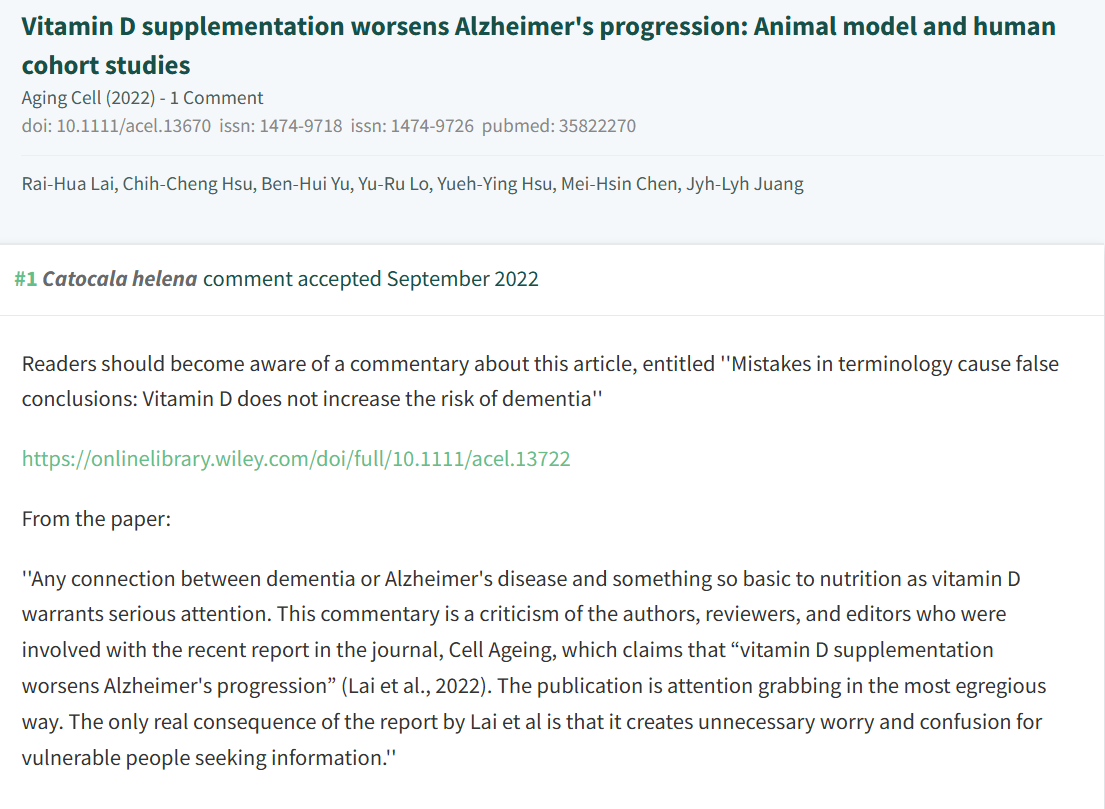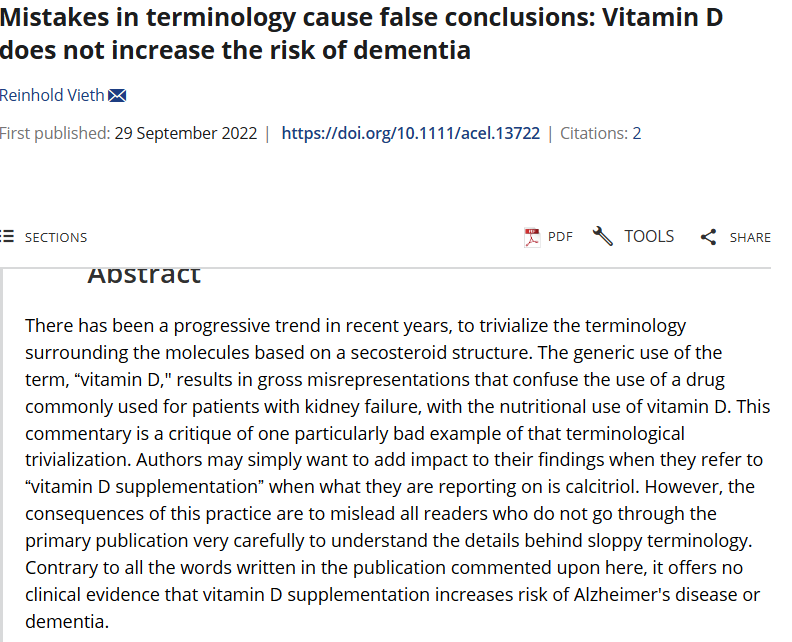Indeed you may be right.
DrFraser,
I’ve been taking 10,000 IU vitamin D3 + 50 mg K2 (MK-4) + 1 mg K2 (MK-7) daily for about 10 years. My blood tests have always been fine with vitamin D levels generally between 80 and 90 ng/ml.
By the way, I’ve been wondering in what way you would use methylene blue in your protocol.
Is that in ng/ml or nmol/l?
The post has been revised to show ng/ml.
Thanks. I thought that was probably the case. I find 3,000 iu will maintain about 90 nmol/L viz 36 ng/ml.
Your MK4 and MK7 figures seem higher than many. Is there a reason for that?
Yes a reasonable % of people need >5,000 IU of D3 daily to achieve a vitamin D in the range of >40 ng/mL. It is however important to take K2 with it, especially if pushing the doses up. Also, given that the upper limit of normal on most assays is 100 ng/mL, being close to that would generally be a reason to check periodically to make sure you aren’t pushing above 100 ng/mL
I’ll put in my standard instructions for methylene blue for my patient’s below. Naturally discuss with your primary care physician or other licensed professional.
Methylene Blue
First, make sure you not on any SSRI or MAO-I antidepressants. Second, with low dose Methylene Blue, it is unlikely, even if you have a G6PD Deficiency that you would not get into trouble – but this compound can cause your red blood cells to “hemolyze” or break down, which can be serious. Especially if you are of Mediterranean or African descent, get this tested (blood test) before starting Methylene Blue. Interesting videos to watch below:
A trial of Methylene Blue is primarily guided by whether this adds mental clarity and decreases fatigue – if so, continue.
Dosing:
Generally start with 8-12 mg each morning (which is often a sufficient daily dose for many people), after 1 week if doing well, and if you have a sense of energy not being optimal later in the day, you can choose to add a second dose around lunch (generally 5-6 hours after your morning dose, but not close to going to bed). If you work out first thing in the morning, generally wait to take this until right after your workout.
Select from:
Nutricel Blue Boost 12 mg. Amazon.com: Methylene Blue (USP Grade) Supplements, Capsule Form, with Added Vitamin C Ester for Enhanced Absorption, Brain Supplement with ATP Fuel for Memory, Focus, Clarity, Cognition, Energy : Health & Household
The advantage of this, is it is encapsulated, so no blue tongue/teeth, but a fixed dose of 12 mg.
Tro Just Blue. Just Blue™ – Troscriptions® Code: FRASER gets your 10% off
The advantage of this is a wafer that can be broken into 4 mg doses. The downside is 4 wafers (16 x 4 mg dose) on subscribe and save ends up being $23 for not very many mg. These can be swallowed or dissolved in the mouth, but allow for smaller doses or adjustments. If starting with these, can start as low as a 4 mg, and gradually go up.
Of 9,267 identified literatures, 23 were eligible for inclusion in the meta-analyses, among which 9 and 4 literatures were included in the dose-response analyses for the risk of dementia and Alzheimer’s disease (AD). Vitamin D deficiency exhibited a 1.42 times risk for dementia (95% confidence interval (CI) = 1.21–1.65) and a 1.57-fold excess risk for AD (95% CI = 1.15–2.14). And vitamin D deficiency was associated with 34% elevated risk with cognitive impairment (95% CI = 1.19–1.52). Additionally, vitamin D was non-linearly related to the risk of dementia (pnonlinearity = 0.0000) and AD (pnonlinearity = 0.0042). The approximate 77.5–100 nmol/L 25-hydroxyvitamin D [25(OH)D] was optimal for reducing dementia risk. And the AD risk seemed to be decreased when the 25(OH)D level >40.1 nmol/L.
77.5–100 nmol/L of vitamin D means between 31 and 40 ng/mL. I’m not sure recommending a higher level is evidence-based @DrFraser. See also: Vitamin D supplementation worsens Alzheimer’s progression: Animal model and human cohort studies 2022
Consistently, our population-based longitudinal study also showed that dementia-free older adults (n = 14,648) taking vitamin D3 supplements for over 146 days/year were 1.8 times more likely to develop dementia than those not taking the supplements. Among those with pre-existing dementia (n = 980), those taking vitamin D3 supplements for over 146 days/year had 2.17 times the risk of mortality than those not taking the supplements.
That being said APOE4 non-carrier females might benefit from it per Vitamin D supplementation and incident dementia: Effects of sex, APOE, and baseline cognitive status 2023?
This has the interesting point that I found with N=1 experimentation a few years ago. If I supplemented with 3,000iu vitamin D I slept better than supplementing with 6,000iu. I also experimented with bolus doses.
The body will have a limited rate at which it can turn Cholecalciferol into 25 Hydroxy Vitamin D (which is what is measured in serum and is the stored form of Vitamin D3. The body converts this into 1,25 Di Hydroxy Vitamin D for the active form and also 24,25 DiHydroxyVitamin D about which there was a debate a few years ago, but I have not studied this.
I think either
a) Unconverted Cholecalciferol disrupts sleep in some way (hence is mildly toxic) or
b) A disposal pathway of excess Cholecalciferol disrupts sleep.
Either way higher supplementation would be likely to make things that depend on good sleep worse.
What I personally do to keep my 25OHD levels high is to supplement with 25OHD.
I have seen research which used a bolus dose of 50,000 iu once a month. That also would be potentially harmful and in fact it found that vitamin D was not much use (or slightly harmful).
This is one of those subtle things where precisely what people do makes a real difference.
FWIW (and you probably already know this), but Methylene Blue’s MAOI activity only significantly occurs at 1mg/kg doses. It’s also a reversible inhibitor, so the effect is quite transient. I would imagine that doses < 0.5mg/kg would be quite safe even with SSRIs. Not that I’m suggesting you change your protocol - serotonin syndrome is quite serious and it’s probably not worth even trialing Methylene Blue even if the risk is very low.
@dicarlo2 I agree with you on this, but need to be cautious with what I advise, especially as a lot of the care I give is a little bit different than standard allopathic medicine.
@adssx On the vitamin D we are left in a poor evidence zone, due to the research on interventions with vitamin D have almost uniformly been based on giving 800-2000 IU BUT not measuring blood levels in response. From TargetD Study we certainly saw the range of doses required to treat those who were deficient - and their goal was just to 40 ng/mL, I believe. Some 13% required >10,000 IU/day to achieve this. We need more data as this fairly simple issue still doesn’t have a good trial to my knowledge where supplementation is checked with blood levels and given to a certain target.
I’m comfortable on the safety of running this in the higher ranges, but I cannot point you to any appropriate research that supports better outcomes with higher Vitamin D. We plainly don’t have the data in the format, to my knowledge. There are a few studies that seem to indicate higher levels = better outcomes, but nothing that is definitive.
I think higher serum levels of 25OHD are good, but depending upon the individual higher levels of cholecalciferol are harmful. This fits with the papers I have read. Ones which give a large dose of cholecalciferol once a month find lower benefits or no benefit.
It goes without saying everything on this thread is entertained as potentially preventative, not curative.
I’m on vacation with kids and on the go so not ideally situated to pull the research together but I strongly urge you to Google each compound along with Alzheimer’s and Google’s new AI will pull the relevant information along with the studies at the very top. HMB seems very promising and my intuition tells me that somehow muscle preservation / performance is connected along certain pathways to brain health so it doesn’t sound surprising.
The real shocker to me was intranasal rifampicin (with resveratrol boosting effectiveness). All I can say is look it up to see for yourself. I was blown away.
Trehalose you already seem to know something about. There might be additional longevity effects from its functions on mitochondria.
Looking at the commentary the research looked at people who were prescribed 1,25 di hydroxy vitamin d who are often people with kidney failure. Hence it was flawed in being reported as supplementation of cholecalciferol
Damn. I never heard of this risk but sure enough trouble falling and staying asleep is a known side effect of higher dosing of vitamin D supplementation and taking vitamin d at night. I’m backing down from 10k EOD starting tomorrow.
Thanks again.
I take vitamin d in the mornings because if its supposed to be sun that is best in the mornings instead of night. But i think the half life is actually high? 2 to 3 weeks or 15 hours depending on form. Might not make a difference then.
If you take 25ohd itself this problem does not arise. I use dedrogyl. Somewhat stupidly it is a prescription molecule in the uk. I take about 20 drops a week.
It is worth understanding the way d3 is metabolised. The molecule we eat or is created from UV is called cholecalciferol. The liver converts this to 25ohd (Calcifediol) which the body stores. The body uses 1,25 di hydroxy vitamin d (Calcitriol) which is made by the kidneys from 25ohd (Calcifediol) on demand.
Thanks a lot! This paper is shit indeed. The others remain though: high serum vitamin D seems associated with more and not less dementia past a certain point.
If you have a list of the papers we could try to isolate the effects of cholecalciferol from calcifediol.

![METHYLENE BLUE: Impacts Longevity By Boosting Mitochondrial Efficiency [2024]](https://img.youtube.com/vi/UV9qeSoUsy0/hqdefault.jpg)

